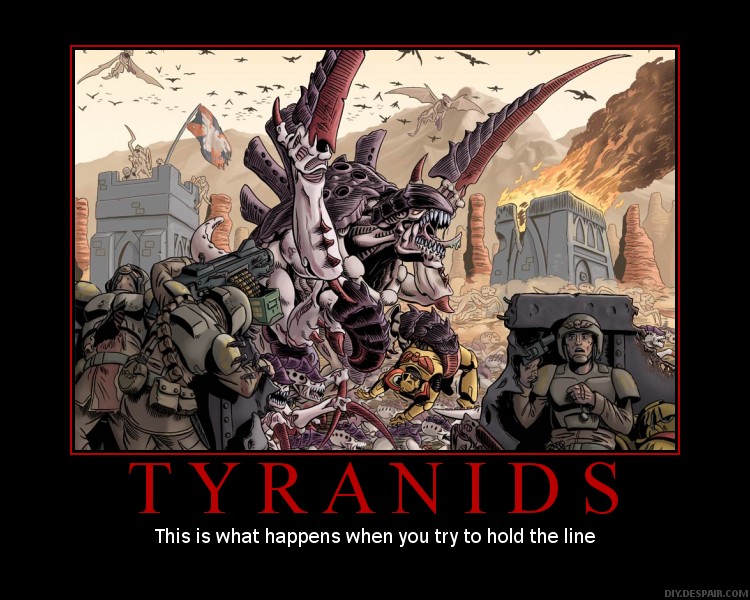40K: Tyranids In the Balance

It’s time we take a proper look at the Tyranid codex, and see it for what it really is.
The Tyranid codex has been out long enough now that we should have a pretty good idea of what it is all about. Needless to say, the Internet has been bombarded with opinions on the issue. So, let’s take one last look at them and see them for what they really are.
The Basics
You’ve heard it before and you’ll hear it again; synergy is key. Tyranids are not a newbie army anymore. Gone are they days of ten Carnifexes and Eternal Warrior. You can’t just put the models down, compare lists, and declare yourself victorious. Now you must play. You must think. You must attempt something called strategy. We can go ahead and just throw it out there, so nobody else brings it up, that 40K is not a balanced system. But, where do we draw the line between balance and the different levels of skill needed to play that army? Is it unbalanced to have codices with various levels of difficulty? Ask yourself that the next time you call a codex weak.
Tyranids are a collective fighting force. If you consider their story then you might have noticed that Tyranids adapt by creating a new bug for each occasion. This approach to battle leads to having multiple types of units that all have various tasks that must be performed in harmony. Tyranids are more the sum of their parts, much in the same way a cell is. Each part of a cell has various purposes but each part is unique. The cell membrane cannot perform the tasks of the nuclei. I believe this is where the negative opinions of Tyranids begin. Space Marines make up the greater majority of the available armies, and when you look at a Space Marine you see independent, almost autonomous, units.
The Musicians
Any army list can be broken up into these specific parts: close combat unit, elite close combat unit, firepower unit, long range support unit, objective holding unit, surprise/psychology unit, fast unit, harassment unit, and buffing unit. Apply what you know about Tyranids to their codex, and you will find that they are capable of being effective in almost any circumstance.
Close Combat / Elite Close Combat Units: A close combat unit is what you think it is. It’s a unit that achieves victory in CC. An elite CC unit is a unit that kills other people’s elite units. For example, Hormagaunts are close combat units, while Warriors with Lashwhips and Boneswords are elite close combat units. This is where Tyranids excel. Trygons, Hive Tyrants, Carnifexes, Warriors, Hormagaunts, and the dreaded Swarmlord are your tools. I don’t think much attention needs to be drawn here. We all know that the name Tyranid is synonymous with close combat.
Firepower / Long Range Support: Tyranids don’t excel at shooting. We have few weapons under AP 4 -which leads me to think that Tyranids are only meant to kill Guardsmen-. But, while we don’t excel at it, we do have enough of it to do what needs to be done. Termigants are good for meat-shields, but put a Devourer on them and they can be quite effective shooters. Perfect for laying down screening fire to soften up targets before letting something else assault them. Hive Guard do excel at anti-tank shooting, and I won’t bother discussing them. Warriors can also provided some nice anti-infantry firepower. Upgrade to the Deathspitter and they can let out enough strength five shots to really hurt a squad of Space Marines before they assault. Zoanthropes, while fickle with the unnecessary four different dice rolls they must go through, are our best change for a surprise spore drop to wipe out a Land Raider really fast. Biovores and Tyrannofexes do provided enough long-range firepower to effectively support troops in the trenches while they trudge up to assault.
Objective Holding Units: Not sure how much we need to touch on this. Tervigons and swarms of troops. They hold objectives well. Just don’t use Feed units.
Surprise/ Psychology / Fast Units: Another area that Tyranids excel. Lictors, Genestealers, Raveners, Shrikes, Harpy, and Winged Hive Tyrants can all add some speed to your force. Tyranids have a multitude of abilities that allow themselves speed and dominion of the board. Hive Commander adds to our reserve roll and allows a troop unit to infiltrate. Pheromone Trail lets units Deep Strike without scattering. Mysetic Spores will put you everywhere and they only mishap off the board edge. Trygons that Deep Strike with little mishap. This is one of the most powerful features that Tyranids have. If used right, we can avoid two turns of shooting, and be in our enemies face at full strength. One thing every Tyranid player knows is that if your troops have to move across the board on foot they will likely lose 25% to 50% of our forces before we see combat. But, if you properly infiltrate your Hormagants and spore pod in those Termagants you can avoid all that. There are also screening methods you can use.
Harassment / Buffing Units: This category is where most misunderstood units fall. Each of the units I will list here have alternate roles, but are used in a way that makes them more like harassment units. Lictors are great for popping up out of nowhere and blowing up a light tank or killing a unit of Devastators. Pyrovores work great at dropping in and smoking Sniping Scouts or Long Fangs hiding in ruins. Where Pyrovores are dismal is in assault. Toughness 4, strength 4, and having one attack; it just does not make sense. Raveners, Shrikes, Rippers, Deathleaper, the Doom of Malan’tai, Harpies: each of these are used to harass your opponent while the rest of your army approaches. They won’t win you the game on their own but they give your enemy something else to shoot at while buying the meat of your army the time that it needs. There are many Buffing units, many of which already serve another role. Venomthropes give cover and make enemies strike at initiative one. Tervigons give Feel No Pain. Hive Tyrants give Preferred Enemy. The list goes on.
Assembling the Orchestra
You put them together and what do you get? Here is an example: You take a Hive Tyrant with wings for some fast support and give him Old Adversary and one set of twin-linked Devourers. He flies around popping light tanks or killing small units or flying in and buffing a unit that is already in CC. You take two units of Hive Guard for that much needed anti-tank. Then a unit of Pyrovores for harassment; to swoop down and flame out a unit that is firing at you from long range. So then you load up on some troops and then throw in a few monstrous creatures. Whenever you finished a Tyranid list, look at it, and ask yourself, “What roles will all my units preform?”. Say to yourself, “My Termagants will march up field shooting away while my Tyrannofex fires from a distance at the enemy tanks. My Hormagants will infiltrate along with my Genestealers to surprise my enemies and put me in their deployment zone. My Lictors will pop up and kill some long range shooters while my Ravenors Deepstrike in and assault his troops falling out of the tanks that the Tyrannofex blew up. The Ravenors will hold the units in combat until the Hormagants can catch up and aid in the fray. My Trygons will run across the board killing everything. And lastly, my Venomthropes will provide cover.” If you do that, you will see that you can formulate a list capable of approaching combat anyway you want. But, to be successful with Tyranids you have to think a few turns ahead. You have to make sure that every unit has a purpose and is set up to achieve it. That is their secret.
One quick note on Synapse. You will have noticed that I did not bother talking about this. The reason is that is Synapse is rarely an issue if you use each unit correctly. Feed is not a danger for CC units if you point them the direction you want them to go. Lurking units usually should be used from a firing position. So just be aware of where your units are going and what they are doing and you will find that failing Synapse checks is not so bad. For those few units or cases where you might need to worry, such as that one time where you have to use Hormagants to hold an objective, make sure that your list always includes some forms of Synapse creatures.
That is my final word on Tyranids. Now its time to go out and learn how to use them and stop spamming the Tyranid forums whining about the rules you don’t like and why you don’t play them anymore. Man up and adapt, like a true bug! What say you?







